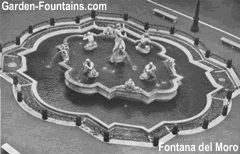 The contract was very specific that portsana (marble), was to be used if Master Ludovico was able to find it for the basins. It also orders that care was to be taken to ensure the stone was not fired or split. Ludovico was able to find the portsana, and undertook the carving of two basins. Per the wooden model, the basins were to be 48 hands long and 30 hands wide (10.8m x 6.75m). These are the measurements of the fountains seen today.
The contract was very specific that portsana (marble), was to be used if Master Ludovico was able to find it for the basins. It also orders that care was to be taken to ensure the stone was not fired or split. Ludovico was able to find the portsana, and undertook the carving of two basins. Per the wooden model, the basins were to be 48 hands long and 30 hands wide (10.8m x 6.75m). These are the measurements of the fountains seen today.
The job was to be completed by June of 1575, and threats were made that the Fountain congregation would give the job to someone else at his own expense. The basins were not completed by June, and in fact by September 1576, the basins were still not delivered. He was still receiving part-payments for the basins, as well as the addition to the travertine steps that were to be in the same shape of the basins.
Even with Master Ludovico’s lateness, another contract was provided to him for the construction of a travertine balustrade. It was to incorporate the flowing lines of the basin and steps, and be large enough to enclose the whole constructions. This was to protect the work from the carts and carriages.
The ornamental sculptures created for both fountains, normally designed as he went, Jacopas life was simplified by the fact that four Tritons that were orders for the fountain in Piazza del Popolo were never used. The statues had been tried out for their original fountain, but were not suitable. Della Porta decided to use these sculptures in the Fountain of the Moor, which would be the fountain at the southern end of the Piazza Navona.
Della Porta enjoyed the look of the Tritons, which feature on leg placed over a shell. Della Porta crafted this from clay, and required specific marble, stating he needed, “"smooth, beautiful [marble] fit for making statues, with well made relief and worked on all sides". Unfortunately the Tritons located on the fountain today are not the originals. These are replicas created by stone cutter Luigi Amici to replace the ancient versions.
Unfortunate the original Tritons were not removed to be preserved in a museum, but moved to a square near Lake Garden at Villa Borghese, where they are at a bigger risk of being vandalized and destroyed forever. Why not have them returned to their original location, and keep them safe from the hands of Roman children, who when playing on the fountain, may cause them to break and further deteriorate?
